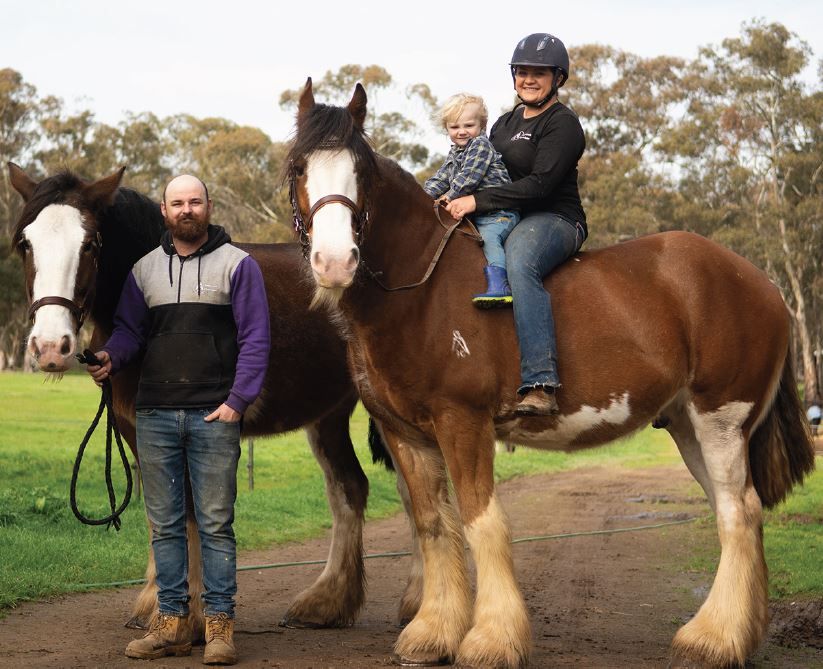September 28th, 2023Clopping on: continuing the Clydesdale tradition

The early development of Australia from its roads to farms would hardly have been possible without the contribution of heavy horses.
They were the trucks and tractors in the time before mechanisation took over, and the most well known of these hard working creatures was the Clydesdale. And despite their size they are considered one of the most docile of horse breeds, with a kind temperament.
However, compared to other breeds such as stock horses or thoroughbreds which are foaled in the hundreds every year, there are comparatively few Clydesdales. Their numbers plummeted after WWI and while there has been a resurgence over the last few decades, there are less than 3000 registered animals in Australia and maybe 10,000 worldwide.
With such a small gene pool, as a breed they were once considered vulnerable to extinction. But that is not going to happen anytime soon thanks to the work of horse people such as Matthew and Jaimie Thompson of Sandy Creek Clydesdales outside of Maldon.
“We have been slowly building up our breeding program since we established the stud in 2014,” says
Matthew, “and we hope to produce seven foals (all registered) this year all of which will be broken in and trained for both riding and harness.”
Matthew and Jaimie’s stud sits on 25 hectares outside of Maldon where they currently run over 20
horses including their stallion Sandy Creek Albert, seven brood mares and an array of colts and fillies.
They share all the day-to-day chores on the farm and training duties and their operation is part of the Commonwealth Clydesdale Horse Society of Australia (established 1918). And, along with their children Hunter, pictured above with his parents, and Billie, the young couple are making a mark in the small specialist world of Australian Clydesdales.
“We have always wanted to improve on the qualities of the horses we have,” says Jaimie. “We will keep all the fillies we produce and we are transitioning to breaking in more of our own horses and suitably matching them to future owners. Over the next eight years we will be building stables and looking at buying another block of land to grow feed.”
The Clydesdale breed was founded in the early 18th century in Scotland when two breeders, John Paterson of Lochlyoch and Scottish peer James Hamilton, imported Flemish stallions and mated them with native draught mares in the Clyde Valley. From these beginnings thousands of Clydesdales were exported to many countries of the world and were known here as the horse that built Australia.
At Sandy Creek Clydesdales they are keeping this history alive, maintaining their traditional role under harness as a work horse.
Matthew is an experienced blacksmith and heavy fabrication engineer and makes and repairs all forms of carriages which allows him to bring the horses out for all sorts of events from weddings to historical displays. However Jaimie is quick to point out that the breed is highly suitable for other tasks
“Riding is actually where the Clydesdales are going. Because these days not everyone is like a farmer who needs eight horses to serve as a tractor. Today most buyers just want one or two. They are used to do dressage, jumping and at Melbourne Royal they have the heavy horse ridden classes. Also Clydie crosses are frequently used as bronc horses in rodeo competitions.”
As the weather finally grows a little warmer this month, Matthew and Jaimie have a very hectic schedule to juggle including clinics, carriage hires and a lot of travelling.
“Our schedule turns pretty chaotic,” says Jaimie. “We are off to Victor Harbour in South Australia to assist with their horsedrawn tram and have Melbourne Royal Show coming up.
“We are competing there but also have Clydesdale and blacksmithing displays going on for the whole 11 days. After that we are off to the Elmore field days doing cart rides then to Nhill in Western Victoria. Then there are weddings in between with the horses and carriages as well as breaking in for outside clients.”
Words & image: Tony Sawrey










